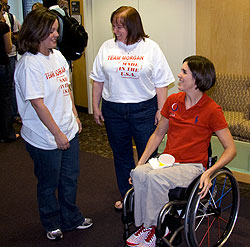Kerri Morgan’s road to the 2008 Paralympic Games in Beijing, China, with the U.S. Track and Field team began when she was training for her first love — quad rugby. Morgan is one of a handful of women who play the rough sport, which involves wheelchairs banging into one another.
While trying to improve her rugby game, Morgan, an instructor in occupational therapy, was approached by Steve Bunn, an area track coach who offered to work with her after watching her play.

“I hadn’t really had anybody tell me ‘I see potential in you, and I want to help you,'” she said. She signed up right away.
But Morgan wasn’t a fan of the track.
“I went out to track practice a couple years before that, and I was in a horrible chair. I hated it, and I was in so much pain,” she said. So she dropped it.
Morgan didn’t make the Paralympic quad rugby team, but determined to get to Beijing, she decided to give track another chance.
Last June, in her sixth wheelchair track meet, Morgan made the U.S. Paralympic Track and Field team. She qualified in the only two events in the T-52 category — the 100 meters and 200 meters.
In the Paralympics, held in mid-September, she finished fifth in both races and set a new U.S. record in the 100-meter race, in which she placed first among the American athletes with a time of 21.56 seconds. Morgan was the first American competitor to finish the 200-meter race with a time of 40:82.
Morgan’s parents, Mike and Joan Morgan, made the trip to Beijing from California. While preparing for her first race, Morgan thought she heard someone calling her name from the crowd.
“I looked over, and the first two people I identify out of the audience are my parents,” she said. “They had their big USA shirts on, and they’re surrounded by Chinese people. It was really cool.”
But Morgan’s adrenaline rush wasn’t only reserved for competition. Organizers arranged for the U.S. team to visit the Great Wall. “The Wall is very old, obviously, so it’s not very accessible,” she said, but there is one area with ramps that lead to the Wall.
“At every phase of ramps or slopes they had security guards or staff there helping,” she said. “When we got to steps, four people came around and carried me up, then put me down at the top,” she said.
However, the language barrier became a problem. The helpers were picking up the athletes by their chairs’ wheels, almost rotating Morgan right out of her chair.
And then there was the celebrity aspect. Everywhere the athletes went, there were autograph seekers. “I probably have my picture with 300 random Chinese families who wanted my signature,” Morgan said.
The celebrity treatment didn’t end when she arrived back on U.S. soil. She was invited with all her Paralympic teammates and the U.S. Olympic team to the White House to meet President George W. Bush and First Lady Laura Bush.